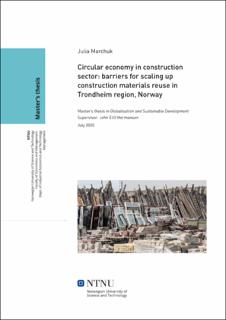| dc.description.abstract | Construction industry is the largest consumer of resources and raw materials in the world. This industry is responsible for approximately 40% of total waste generated in the world and contributes significantly to the release of carbon dioxide. Recently, emerged stricter environmental regulation in the world put the construction sector under increasing pressure to reduce raw material consumption and its environmental impact.
The circular economy approach can help construction sector to minimize its footprint, and avoid rising prices, delays, and other consequences of resource scarcity. Reuse plays an important role in the circular economy model. The reuse of construction materials and components has high potential in reducing negative environmental impacts, related to the extraction, processing and production of construction components and materials and reducing construction costs, and also could cause community benefits through providing training and work places for many people (European Construction Sector Observatory, 2019).
According to Eurostat (2019), among construction and demolition waste (C&DW) management options in Norway, recycling is prioritized and constitutes approximately 57% of total amount of construction and demolition waste treatment. At the same time, landfill disposal, which is on the lowest rank in waste management hierarchy, constitutes more than 30% of total C&DW management in Norway. In comparison to other European countries, Norway has almost the highest rate of construction and demolition waste landfilling. Thus, this study focuses on identification of challenges/barriers on the way for scaling up construction materials reuse, which is on the higher rank in waste management hierarchy than recycling and should be prioritized measure for waste treatment in future. This study shows that main barriers for materials reuse in Trondheim region’s construction sector are interconnected and linked to an underdeveloped market for professional players, quality of secondary materials, legal issues, traceability, technological challenges, and responsibility issues. As an outcome of analysis of identified challenges/barriers, recommendations that can be used by different actors are proposed. | |
